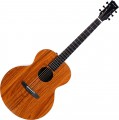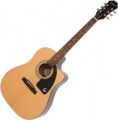Type
The type of tone block installed in a guitar with a pickup (see above).
The tone block is responsible for processing the signal coming from the pickup before applying this signal to the output of the instrument. Such processing includes at least frequency correction, often also amplification; in addition, it is through the tone block that such functions as a tuner for tuning and an equalizer are implemented (see below). And the types of such blocks can be as follows:
— Active. Tone blocks operating from their own power source (usually a replaceable battery). Such modules are more complicated and more expensive than passive ones, besides, when using them, you need to monitor the condition of the batteries and change them in time. On the other hand, the active operation scheme allows you to implement many advanced functions: high-quality frequency correction, gain, impedance matching with an external amplifier, as well as the equalizer and tuner mentioned above. Thus, most guitars with pickups nowadays are equipped with active tone blocks.
— Passive. Passive tone blocks do not have electronics that require additional power, so they are inexpensive and extremely easy to use. At the same time, the capabilities of such blocks are much more modest: for example, timbre correction in them is carried out only by cutting off “extra” frequencies, and there is no talk of amplification at all. This variant has not been widely used.
Equalizer
The presence in the guitar tone block (see above) of the
equalizer function.
The equalizer in this case means the ability to set the volume level for each individual frequency band. This allows you to quite accurately adjust the tone block to the desired sound. Guitar equalizers usually have less than 3 bands (low, medium, high frequencies) — this is quite enough for the initial adjustment (it makes sense to fine-tune the sound already on external equipment).
Tuner
The presence of a built-in
tuner in the guitar tone block (see above).
The tuner is used when tuning the guitar: it “listens” to each string and tells the musician how much the pitch of its sound corresponds to the reference (higher, lower, normal). This equipment greatly simplifies the setup. Tuners can also be produced as external devices, however, the presence of such electronics directly in the tone block is much more convenient: at least, it is always at hand and is not lost. For more details about the features of such devices, see "Tuner" below.
Cutaway
Special
cutout on the body of the guitar. It is located at the base of the neck, to the right of it, if you look at the upright guitar from the front (in left-handed models — on the left). This feature makes it much easier to play on the upper frets (located near the rosette): without a cutout, the body would prevent reaching them. Therefore, this feature is highly desirable for guitarists who play notes at high frets (from the 12th and above).
There is an opinion that the cutout negatively affects the acoustics of the guitar (reduces the useful volume of the body, reduces the volume and saturation). However, in most cases, this effect is almost imperceptible, especially since manufacturers often use various tricks to compensate for this effect.
Pickguard
A special protective pad that protects the soundboard from accidental contact with the pick.
The pickguard is usually located at the sound hole below the strings (if the guitar is considered in the standard playing position). With a dynamic, aggressive performance (especially when playing chords), it is in this place that the pick clamped in the hand most often hits; hitting an unprotected body causes damage to the surface of the body, which degrades the appearance and acoustic characteristics of the guitar. Pickguard prevents such damage: such an overlay is usually made of a hard material that is resistant to contact with most picks. Accordingly, the presence of this part is highly recommended if you plan to use the pick extensively when playing.
Note that the protective overlay usually differs in colour from the main material of the deck, due to which it is clearly visible.
Top deck
The material from which the top of the guitar is made is the flat part of the body on which the bridge (see below) and the sound hole are located.
A wide variety of materials are found in modern guitars — from
spruce, maple or
cedar, which are familiar in our latitudes, to expensive
mahogany and “exotics” like bubinga (“African rosewood”) or koa, which grows only in Hawaii. Each material has its own characteristics that affect the sound and other properties of the instrument (for example, appearance and durability). However, the sound of a guitar largely depends on a number of other factors besides the material — the type of instrument, the shape of the body, etc. Therefore, models made of similar materials may well sound noticeably different. In addition, note that expensive woods can be used solely for aesthetic purposes and have no advantages over cheaper materials.
In light of all this, we can say that the data on materials are more of a reference value, and when choosing, it is more likely to focus on more significant characteristics (for example, the same body shape), as well as practical data about the tool (reviews, reviews, audio recordings of the game etc.). Detailed data on materials may be required only by professional musicians, luthier masters, etc.; this information, if desired, can be found in special sources.
Bottom deck
The material from which the lower soundboard of the guitar is made is a flat surface on the opposite side from the upper soundboard (it is this surface that is adjacent to the musician's body when the instrument is held normally).
The value of this parameter is described in detail in the “Upper deck” section — what is stated there is also true in this case. We only note that a wider range of materials is used for the lower deck: this part is less demanding on the characteristics of the material, which gives manufacturers additional choice.
In terms of specific materials,
rosewood,
sapele,
maple,
meranti and
nato, among others, enjoy considerable popularity in modern times. Here is a brief description of each of them:
— Rosewood. A name that combines the wood of several species of tropical trees. This material is said to provide deep sound and enhance bass quality, thereby improving the guitar's efficiency when playing rhythm parts on chords.
— Sapele. Also known as "African mahogany" due to its characteristic hue. It contributes to an even sound with medium depth and good expression of individual notes, which is considered important especially in solo parts.
— Maple. Maple wood is prone to a rather sharp and sonorous sound without much depth. However, this is
...not a drawback, but a feature: for some styles of music, just such a coloring of the sound is perfect.
— Meranti. Wood of trees of the genus Shorey, growing in the tropical forests of Southeast Asia. This material is mainly used in instruments manufactured by Yamaha, mainly classical guitars and ukuleles — it is for these varieties that meranti is considered the best option.
— Nato. A relatively inexpensive variety of mahogany (mahogany) used in guitars in the corresponding price range. Contributes to a dense, but not very bright sound.Shell
The material from which the side of the guitar is made is the “side” surface of the body, which unites the upper and lower soundboards (see above).
About the meaning of the material of the body, see paragraph "Top deck" — everything stated in it is also true for the shell. Unless the range of materials used for this part is noticeably wider; also note that most often the material of the shell coincides with the material of the bottom deck. Here is a summary of some of the more popular options:
— Rosewood. A name that combines the wood of several species of tropical trees. This material is said to provide deep sound and enhance bass quality, thereby improving the guitar's efficiency when playing rhythm parts on chords.
— Sapele. Also known as "African mahogany" due to its characteristic hue. It contributes to an even sound with medium depth and good expression of individual notes, which is considered important especially in solo parts.
— Maple. Maple wood is prone to a rather sharp and sonorous sound without much depth. However, this is not a drawback, but a feature: for some styles of music, just such a coloring of the sound is perfect.
— Meranti. Wood of trees of the genus Shorey, growing in the tropical forests of Southeast Asia. This material is mainly used in instruments manufactured by Yamaha, mainly classical guitars and ukuleles — it is for these varieties that meranti is considered the best option.
— Nato.... A relatively inexpensive variety of mahogany (mahogany) used in guitars in the corresponding price range. Contributes to a dense, but not very bright sound.
Bridge
The material from which the bridge (string holder) of the guitar is made is a device with which the strings are attached to the top deck.
Theoretically, the colour of the sound of an instrument depends on the characteristics of all its details. However, in the case of the bridge, this influence is so insignificant that the data on the material in this case are more of general reference and advertising than of real practical value. The variety of such materials is quite large; among the most common are
rosewood,
mongoy and
ebony.

